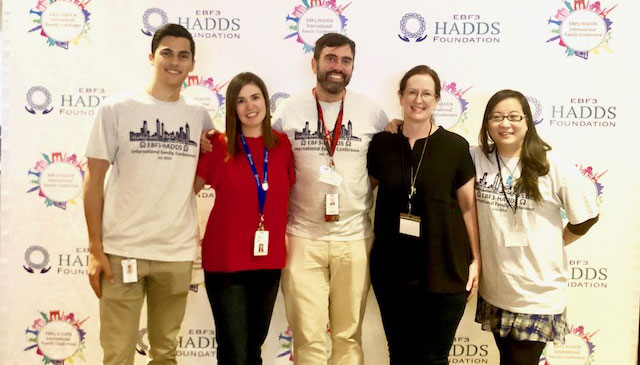
The Jan and Dan Duncan Neurological Research Institute (NRI) at Texas Children’s Hospital recently hosted the first-ever family conference for EBF3-HADD (Hypotonia, ataxia and delayed development) syndrome (HADDS). Medical residents, genetics counseling students and research scientists joined more than 20 families from across North America that attended in person and 13 families that participated via live-streaming services from countries around the world – including Ireland and Australia – making it a truly international event.
The conference was organized by the EBF3-HADDS Foundation, a nonprofit organization created in 2018 by families to promote awareness, research and support for this genetic syndrome. The foundation was co-founded by Ashley LeMaire and her husband, Mark. After one of their children was diagnosed with HADDS in 2016, the LeMaires started a Facebook group for HADDS families. In just two years, that group has grown into an international community and was the impetus behind the foundation’s creation.
“Our HADDS community is a motivated and talented group of families dedicated to supporting research, education and advocacy efforts for HADDS patients, and we support each other on this journey,” said LeMaire, who is a clinical neuropsychologist at the Menninger Clinic, assistant professor of Psychiatry & Behavioral Sciences at Baylor College of Medicine, and also board member of the EBF3-HADDS Foundation. “There is still much to learn about HADDS, but when you have such a dedicated team of physicians and researchers collaborating with families to learn about the condition and provide needed support, it fosters so much hope for our families.”
During the conference, guests attended presentations on a variety of HADDS-related topics given by NRI researchers Drs. Hsiao-Tuan Chao and Michael Wangler; pediatric urologist Dr. Irina Stanasel, a former Texas Children’s fellow; Texas Children’s genetic counselor Pilar Magoulas; and Geraldine Bliss, research director of the Phelan-McDermid Foundation. Additionally, Chao and Wangler offered clinical evaluations for patients, and attendees were also able to tour research labs and facilities at the NRI, where one of the first genetic discoveries for HADDS was made in 2016, and the first lab (Chao’s) devoted to understanding the biology of this disorder.
A search for answers
If you’ve never heard of HADDS, there’s a good reason. The rare genetic disorder, caused by a mutation in the EBF3 gene, was only discovered in 2016 by Chao and Wangler when they were training in NRI investigator Dr. Hugo Bellen’s lab, in collaboration with colleagues at the Undiagnosed Diseases Network (UDN) and New York University Langone Health.
The UDN had been stumped by a case in which a child exhibited symptoms including impaired speech and cognition, low muscle tone, balance and gait issues, reduced ability to feel physical pain, and an inability to show facial emotional expressions. Though earlier DNA sequencing had yielded a few candidate genes, there wasn’t a significant patient cohort or research to help determine which gene was responsible for the symptoms.
Researchers selected EBF3 as the most likely candidate gene. Chao then used fruit flies to mimic mutations to better understand EBF3’s role, and within a few months three patients were found who presented with similar symptoms and similar mutations in the EBF3 gene.
As result of those efforts, more than 200 patients with HADDS have been identified to date.
“The gene discovery of EBF3 illustrates the ‘Power of One’ in medicine and biomedical research, how a single patient with an undiagnosed disorder – a ‘medical mystery’ – can lead to the discovery of a gene responsible for a previously unknown disorder,” Chao said. “This becomes the starting point to develop the diagnostic tests and therapies that can transform the lives of many patients and their families.”
Since 2017 Chao and Wangler have offered monthly clinical evaluations for HADDS patients at Texas Children’s and have now seen the largest number of such patients at any single institution worldwide. They are also enrolling patients in a study to better understand the condition and to help translate research into potential clinical interventions in the future.
The conference was a testament to the power of teamwork and collaboration in research, and also shows how dedicated parents and volunteers from across the globe can work together to build a community of support.

